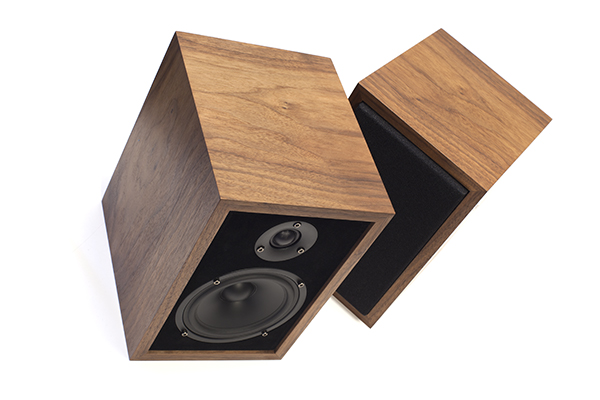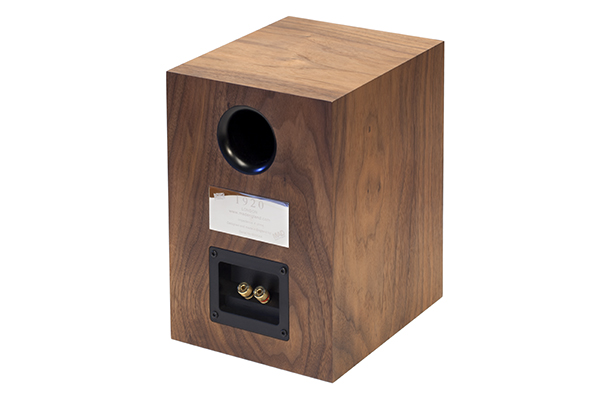A Three-Letter Word For Fun: MAD A great pair of British Mini Monitors
By Jeff Dorgay If I had to make a bet, I’d put my money on the Brits taking the prize for understatement.
If I had to make a bet, I’d put my money on the Brits taking the prize for understatement.
Unpacking the 1920 loudspeakers from British manufacturer MAD (for “My Audio Design”), it’s tough not to have an internal dialog that goes something like, “Two and a half grand for these? They are mad!” But, looking past the relatively simple-looking box speakers, one soon notices gorgeously mitered corners and an exceptional attention to detail paid on behalf of the craftsmen behind these. Hmmm. Some understated British artistry, perhaps? I take the necessary photos and roll the speakers into listening room two, which, at 13 feet by 16 feet, is perhaps even a bit on the large side for a pair of small speakers—truly mini-monitors, in this case. The next thought that comes to mind is “LS3/5a clone,” until I turn the speaker around and see a rear-facing port.
At $2,650 per pair, the 1920s are towards the high end of the price scale for this category. Their obvious competitors are the KEF LS50 ($1,499/pair), which we haven’t reviewed yet; the Harbeth P3ESR ($2,200/pair); and the Stirling Broadcast LS3/5a V2 ($1,999/pair). A mint pair of original LS3/5a speakers can command up to $2,000 per pair. While the originals do have a certain vintage charm, they are notably woolly sounding in the world of 21st-century monitors. Colleen Cardas Imports is handling US distribution and now has three dealers, with more on the way.
A mini-monitor, properly optimized in a small room, is one of audio’s guilty pleasures. Paired with a great amplifier, these speakers will provide ample bass quantity and well-above-average bass quality, going a long way to convince you that you won’t ever need a subwoofer. But don’t forgo good stands, as they are essential to getting the maximum output from the 1920s. Just place these on a pair of high-mass stands (sand filled Sound Anchors are my choice) after applying your favorite sticky substance to couple the speakers to said stands, and expect to be wowed.
Jumping Right In
Auditioning the 1920s begins with the Zombies’ classic, “Time of the Season.” What better way to audition a British speaker than with some of the best of the British Invasion? Immediately, the spatial characteristics of these speakers reveal a massive soundstage in the small room, with things clearly delineated and with solid bass—and rock-solid pace. The added dynamics of the original mono record is an absolute blast with these speakers. Rod Argent’s keys leap from the speakers. When mated to the Conrad Johnson MV-50C1 power amplifier, the 1920s confirm the manufacturer’s spec sheet: These little speakers are incredibly easy to drive. Even the 20-watt-per-channel Carver Black Magic amplifier has no problem playing these speakers to maddening levels. (Pardon the pun.)
Ry Cooder’s light touch on the acoustic guitar at the beginning of “The Very Thing That Will Make You Rich (Makes Me Poor),” from the Bop Till You Drop album, hovers just above the speakers, with Cooder well out in front of them. Cat Power’s “Nothin’ But Time,” from Sun, her current album, has a more modern feel, laden with weighty synth bass riffs, again allowing the 1920s to sound so much larger than they seem capable. Closing your eyes to concentrate on the presentation, it’s easy to think you are listening to much bigger speakers, only to open your eyes and find this pair of tiny audio morsels before you. An equally spacious presentation is had with Little Village’s “Don’t Think About Her When You’re Trying to Drive.”
 Tonality + Dynamics = Bliss
Tonality + Dynamics = Bliss
The performance of the 1920s is especially excellent during playback of a slew of acoustic standards. But, while the speakers are not as rolled-off sounding on the top end as either the Harbeths or the vintage LS3/5as on hand, they are not quite as extended as the Penaudio Cenya or Dynaudio Confidence C1 IIs that I have here for comparison. (To be fair, the Cenyas and C1 IIs are considerably more expensive.) With the 1920s, it’s a nice, gentle roll-off, which will not be noticed on all but the best audiophile recordings and that, more often than not, goes a long way at making digital files and budget solid-state amplifiers considerably more listenable.
The only time I found the tonal characteristic of the 1920s a bit too soft for my taste was when using certain vintage tube amplifiers. With the Dynaco ST-70 or Harman Kardon A500 integrated amp, for example, even digital files come across as slightly dull. But, having drawn that line in the sand, the combination of vintage tube amplification and 320-Kb/sec MP3 files sounds much better than it has a right to.
All things considered, the extra efficiency, slam and bass weight are what separate the MAD 1920s from their comparably priced brethren. You won’t mistake these for a pair of floorstanders, but they open up and breathe so much more than the other small speakers we’ve experienced at this price level. While the Harbeth and Stirlings both present a benign enough load to drive with a 20-watt amplifier, they are still rated in the range of 83 to 84 dB—which means that a low-power amp can’t deliver the dynamic peaks like it can with a speaker rated at 90 dB.
Crazy Imaging
If you are new to the small British monitor thing, the sonic image that the 1920s present will spoil almost everything else for you. From the first tap of the hi-hat on the title track to Donovan’s Mellow Yellow, the term “pinpoint imaging” takes on a new meaning, especially if you dim the lights just a bit to keep your eyes from sending visual information to your brain that might otherwise distract processing power from your auditory nerves. Donovan sounds as if he’s singing just in front of your face, with his overdubs floating in a sea of handclaps and horns. And the separation between the flute and the oboe in “Jennifer, Juniper” is magnificent.
Maybe it’s the stunning imaging that these old studio records present, or perhaps it’s the strong British heritage thing, but I just kept going back for more British Invasion records to play on these speakers. I swear I was having flashbacks during Donovan’s “Hurdy Gurdy Man.” But then, a brief detour spent on a number of Duran Duran and Thompson Twins tracks from the ’80s transitioned me back to the 21st century—and it was still good.
On the deep-bass side of the musical universe, Dungen and Dr. Dre are both off the menu at all but modest levels. You can only cheat physics so far, and the 1920s pull off a major sonic feat already. But heavy rock and hip-hop are simply not a match for these speakers, should you really want to crank it up. But I’m guessing that, if this stuff happens to be at the top of your music menu, you’re not looking at mini-monitors anyway. To use an old audiophile cliché, the 1920s are mostly guilty of omission. They remind me of a first-generation VW Golf GTI or Mazda MX5—they’re tons of fun to drive between 20 and 80 mph, which is where we’re stuck living most of the time. But if you have a modest amplifier, a medium- to small-sized room and few pipe-organ records in your collection, you won’t even know what you’re missing.
Smart is the New Sexy
A quick visual once-over of the 1920s and you might just pass them by. While the small box is well executed, these aren’t head-turners. But inside it’s a completely different story—an abundance of high-grade audiophile parts lurk: ultra-pure silver internal wiring on the tweeter, plus point-to-point wiring with equally zooty copper wire. Best of all, these are hand assembled in the UK, with all components hand tested and matched before the construction process begins.
Don’t think of the MAD 1920 as a clone of the LS3/5a, nor as an update or replacement for it. It will just raise your dander. But do pay close attention to them—they are sleepers. And don’t let the understated box fool you. These speakers are the new standard for small monitors.
The MAD 1920 loudspeakers
MSRP: £1,500 (US pricing, $2,650)
US Distributor: Colleen Cardas Imports www.colleencardasimports.com
Peripherals
Preamplifier Burmster 011
Power Amplifier Conrad Johnson MV-50C1, Pass Aleph 3, Carver Black Magic 20.
Analog Source Rega RP6/Exact, SME 10/Sumiko Blackbird
Digital Source Sooloos Control 15, Aurender S10, Light Harmonic DAC
Cable Cardas Clear
Accessories GIK Room Treatments, Audience aR6-TSS Power Line Conditioner, Furutech DeMag and DeStat, Audio Desk Systeme RCM



